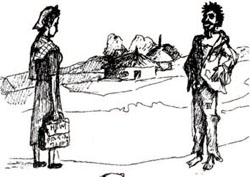Introduction
Mental disorders vary in degree or severity from a mild illness that causes limited suffering to severe conditions that cause marked distress to the person with the illness and their families. The more extreme and distressing disorders are simply termed severe mental illness (SMI). Individuals with SMI are those with an illness that severely restricts their day-to-day activities, such as working in the fields, attending expected community activities like funerals, and carrying out their family responsibilities.

Like many healthworkers, you have probably come across individuals with SMI (Figure 10.1) and may have felt you cannot properly assess or speak to them. This feeling may partly be because you think it is difficult to make sense of what a person with SMI says, or you may feel intimidated by thinking that their behaviour can be unpredictable. These feelings and thoughts are not unique to you. Many health professionals without experience in mental health feel this way. This study session will help you to see mental health problems – including SMIs – more realistically.
We begin with describing the most common mental illnesses in communities like yours, and give their classification in terms of severity. We will then describe how you can detect people with mental illness in your community. You will also learn about the common risks associated with mental disorders and how you can assess these risks, with the main focus on self-harm and suicide. Further details on general assessment of mental illness will be provided in Study Session 11.